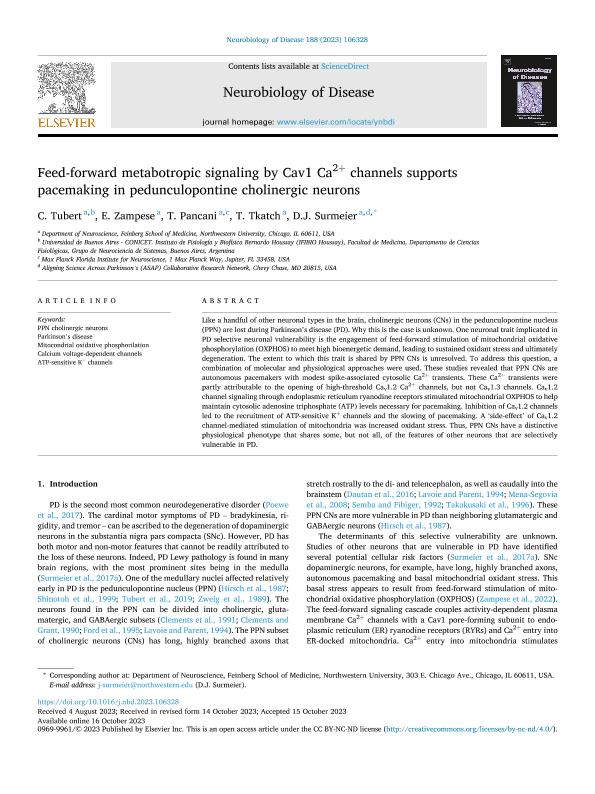Artículo
Feed-forward metabotropic signaling by Cav1 Ca2+ channels supports pacemaking in pedunculopontine cholinergic neurons
Fecha de publicación:
11/2023
Editorial:
Academic Press Inc Elsevier Science
Revista:
Neurobiology of Disease
ISSN:
0969-9961
Idioma:
Inglés
Tipo de recurso:
Artículo publicado
Clasificación temática:
Resumen
Like a handful of other neuronal types in the brain, cholinergic neurons (CNs) in the pedunculopontine nucleus (PPN) are lost during Parkinson's disease (PD). Why this is the case is unknown. One neuronal trait implicated in PD selective neuronal vulnerability is the engagement of feed-forward stimulation of mitochondrial oxidative phosphorylation (OXPHOS) to meet high bioenergetic demand, leading to sustained oxidant stress and ultimately degeneration. The extent to which this trait is shared by PPN CNs is unresolved. To address this question, a combination of molecular and physiological approaches were used. These studies revealed that PPN CNs are autonomous pacemakers with modest spike-associated cytosolic Ca2+ transients. These Ca2+ transients were partly attributable to the opening of high-threshold Cav1.2 Ca2+ channels, but not Cav1.3 channels. Cav1.2 channel signaling through endoplasmic reticulum ryanodine receptors stimulated mitochondrial OXPHOS to help maintain cytosolic adenosine triphosphate (ATP) levels necessary for pacemaking. Inhibition of Cav1.2 channels led to the recruitment of ATP-sensitive K+ channels and the slowing of pacemaking. A ‘side-effect’ of Cav1.2 channel-mediated stimulation of mitochondria was increased oxidant stress. Thus, PPN CNs have a distinctive physiological phenotype that shares some, but not all, of the features of other neurons that are selectively vulnerable in PD.
Archivos asociados
Licencia
Identificadores
Colecciones
Articulos(IFIBIO HOUSSAY)
Articulos de INSTITUTO DE FISIOLOGIA Y BIOFISICA BERNARDO HOUSSAY
Articulos de INSTITUTO DE FISIOLOGIA Y BIOFISICA BERNARDO HOUSSAY
Citación
Tubert, Cecilia; Zampese, E.; Pancani, T.; Tkatch, T.; Surmeier, D .J.; Feed-forward metabotropic signaling by Cav1 Ca2+ channels supports pacemaking in pedunculopontine cholinergic neurons; Academic Press Inc Elsevier Science; Neurobiology of Disease; 188; 11-2023; 1-14
Compartir
Altmétricas




